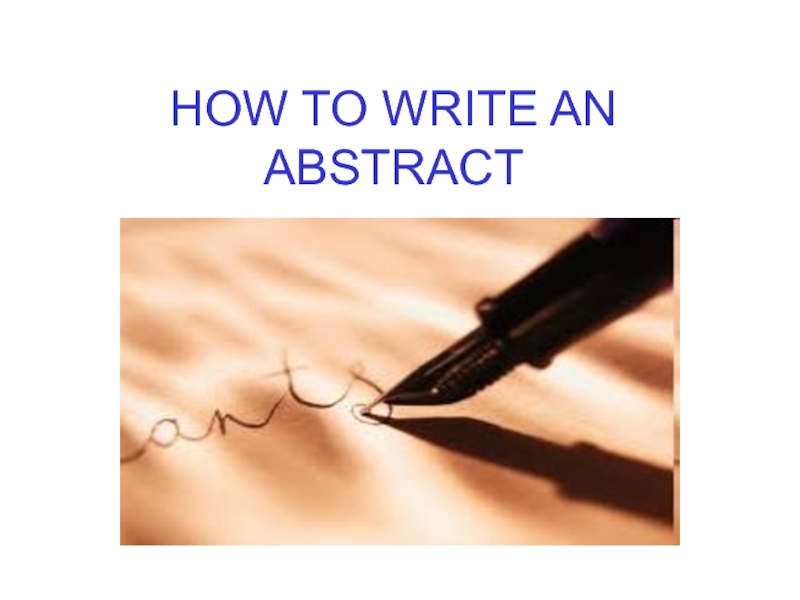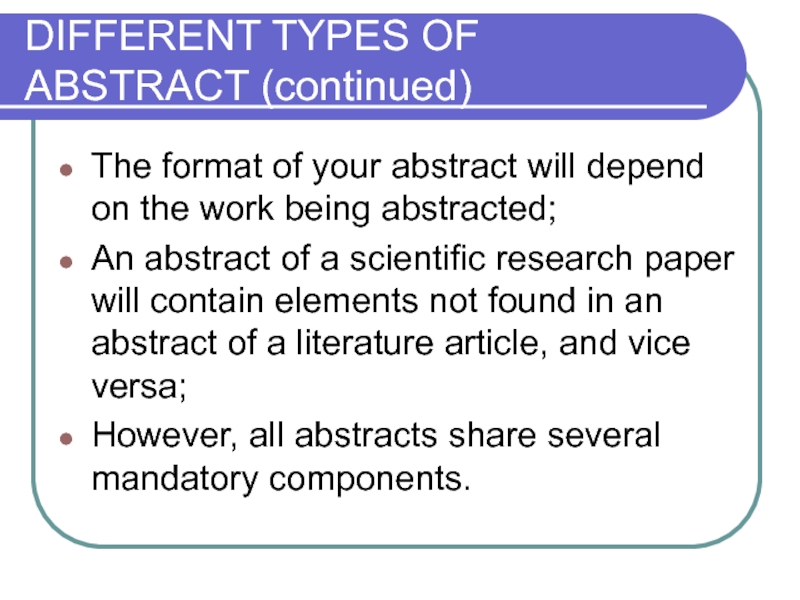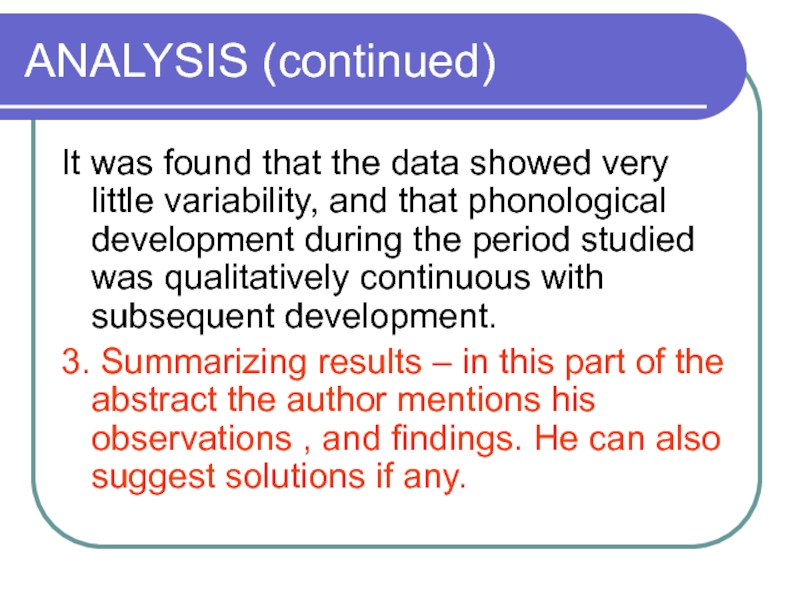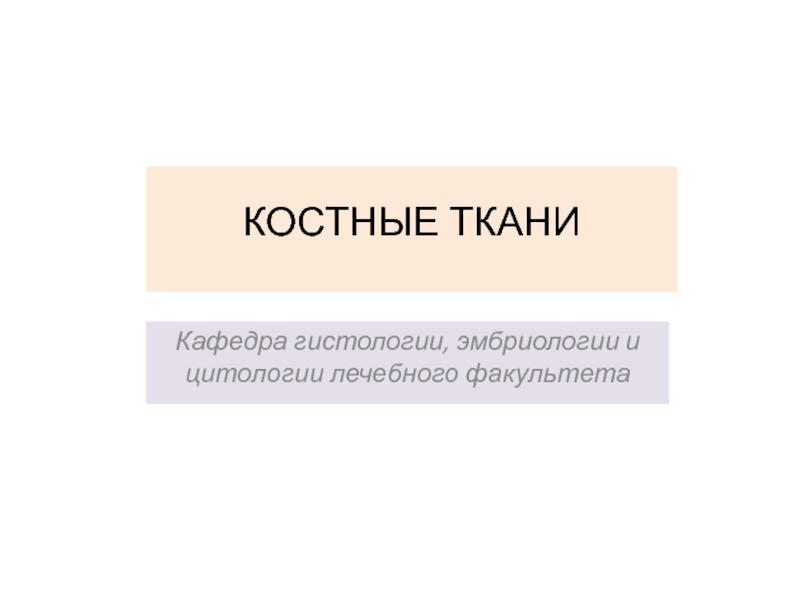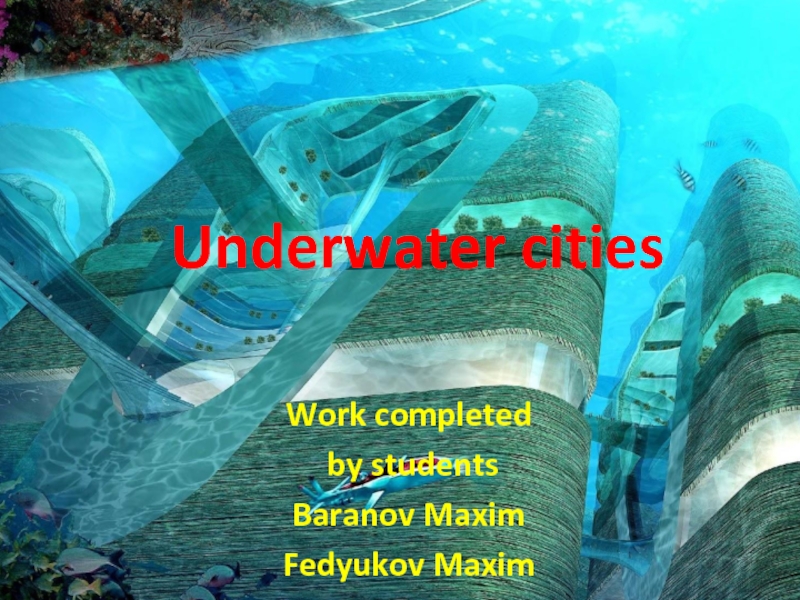Разделы презентаций
- Разное
- Английский язык
- Астрономия
- Алгебра
- Биология
- География
- Геометрия
- Детские презентации
- Информатика
- История
- Литература
- Математика
- Медицина
- Менеджмент
- Музыка
- МХК
- Немецкий язык
- ОБЖ
- Обществознание
- Окружающий мир
- Педагогика
- Русский язык
- Технология
- Физика
- Философия
- Химия
- Шаблоны, картинки для презентаций
- Экология
- Экономика
- Юриспруденция
HOW TO WRITE AN ABSTRACT
Содержание
- 1. HOW TO WRITE AN ABSTRACT
- 2. IN THIS LESSONWHAT IS AN ABSTRACTWHO WRITES
- 3. WHAT IS AN ABSTRACT?A short, self-contained, powerful
- 4. WHAT IS AN ABSTRACT? (continued)An abstract is
- 5. WHO WRITES IT?Usually the author of the
- 6. FOR WHAT PURPOSES?To persuade the reader to
- 7. WHO READS IT?Same-field professionals (e.g. linguists, psychologists,
- 8. DIFFERENT TYPES OF ABSTRACTAbstracts are genre-sensitive (i.e.
- 9. DIFFERENT TYPES OF ABSTRACT (continued)Abstracts are usually
- 10. DIFFERENT TYPES OF ABSTRACT (continued)Informative abstracts describe:What
- 11. DIFFERENT TYPES OF ABSTRACT (continued)Descriptive abstracts are
- 12. DIFFERENT TYPES OF ABSTRACT (continued)The format of
- 13. WHAT TO INCLUDEReason for writing: What is
- 14. WHAT TO INCLUDE (continued)Methodology: An abstract of
- 15. WHAT TO INCLUDE (continued)Results: Again, an abstract
- 16. WHAT TO INCLUDE (continued)To put it simple:What
- 17. WHAT NOT TO INCLUDEInformation not contained in
- 18. ANALYSIS OF AN INFORMATIVE ABSTRACTThis paper sets
- 19. ANALYSIS (continued)The complete set of word forms
- 20. ANALYSIS (continued)It was found that the data
- 21. ANALYSIS (continued)It is suggested that the phonologically
- 22. THANK YOU FOR YOUR ATTENTION
- 23. Скачать презентанцию
IN THIS LESSONWHAT IS AN ABSTRACTWHO WRITES ITFOR WHAT PURPOSESWHO READS ITDIFFERENT TYPES OF ABSTRACTWHAT TO INCLUDEWHAT NOT TO INCLUDESOME EXAMPLES
Слайды и текст этой презентации
Слайд 3WHAT IS AN ABSTRACT?
A short, self-contained, powerful summary of an
article, paper or thesis;
Length: between 150 and 250 words;
Layout: usually
one single paragraph; font size is different from the main text;Position: usually at the beginning of the paper (but it can appear elsewhere, e.g. in book of abstracts or on-line);
Слайд 4WHAT IS AN ABSTRACT? (continued)
An abstract is an original document,
not a collection of quotations taken from the text it
summarizes, i.e. it must be able to stand alone.It does not contain vague statements which force the reader to refer to the main text.
Слайд 5WHO WRITES IT?
Usually the author of the paper, because they
have a first hand knowledge their piece of research;
Sometimes professional
writers, who abstract books and articles for a wide audience.Слайд 6FOR WHAT PURPOSES?
To persuade the reader to see the full
text
To help readers decide if the article is relevant for
their purposesTo answer a call of paper in a conference
To make it possible for your piece of research to appear in on-line publication databases (indexing)
Слайд 7WHO READS IT?
Same-field professionals (e.g. linguists, psychologists, biologists) looking for
further information;
Teachers having to evaluate future specialists’ achievements;
Students charting research
in a given area.Слайд 8DIFFERENT TYPES OF ABSTRACT
Abstracts are genre-sensitive (i.e. components vary according
to discipline)
an abstract of a social science or scientific work
may contain the scope, purpose, results, and contents of the work.an abstract of a humanities work may contain the thesis, background, and conclusion of the larger work. An abstract is not a review, nor does it evaluate the work being abstracted.
Слайд 9DIFFERENT TYPES OF ABSTRACT (continued)
Abstracts are usually divided into two
main categories:
DESCRIPTIVE AND INFORMATIVE
Descriptive abstracts describe:
What the text
is aboutThe issues or problems explored
The purpose and methodology of the research
Слайд 10DIFFERENT TYPES OF ABSTRACT (continued)
Informative abstracts describe:
What the text is
about
The issues or problems explored
The purpose and methodology of the
researchThe results
The conclusion and recommendations
Слайд 11DIFFERENT TYPES OF ABSTRACT (continued)
Descriptive abstracts are often written before
a project is completed;
Emphasis is placed on the problem and
method;They may be required for conference paper proposals or for progress reports;
Informative abstracts are written after a project has been completed;
Emphasis is placed on the results and conclusion of the project.
Слайд 12DIFFERENT TYPES OF ABSTRACT (continued)
The format of your abstract will
depend on the work being abstracted;
An abstract of a scientific
research paper will contain elements not found in an abstract of a literature article, and vice versa;However, all abstracts share several mandatory components.
Слайд 13WHAT TO INCLUDE
Reason for writing:
What is the importance of the
research? Why would a reader be interested in the larger
work?Problem: What problem does this work attempt to solve? What is the scope of the project? What is the main argument/thesis/claim?
Слайд 14WHAT TO INCLUDE (continued)
Methodology:
An abstract of a scientific work may
include specific models or approaches used in the larger study.
Other abstracts may describe the types of evidence used in the research (e.g. qualitative interviews, book reviews, etc.)Слайд 15WHAT TO INCLUDE (continued)
Results:
Again, an abstract of a scientific work
may include specific data that indicates the results of the
project. Other abstracts may discuss the findings in a more general way.Implications: What changes should be implemented as a result of the findings of the work? How does this work add to the body of knowledge on the topic?
Слайд 16WHAT TO INCLUDE (continued)
To put it simple:
What the author did;
How
the author did it;
What the author found;
What the author concluded.
Слайд 17WHAT NOT TO INCLUDE
Information not contained in the original work;
References
to other work;
Quotations from the original work or from other
works;Lengthy explanations of words and concepts;
Unexplained acronyms or abbreviations;
Tables and maps.
Слайд 18ANALYSIS OF AN INFORMATIVE ABSTRACT
This paper sets out to examine
two findings reported in literature: one, that during the one-word
stage a child’s word productions are highly phonetically variable, and two, that the one-word stage is qualitatively distinct from subsequent phonological development.1. Introducing purpose of paper – this part of the abstract gives a precise indication of the author’s intention or thesis.
Слайд 19ANALYSIS (continued)
The complete set of word forms produced by a
child at the one-word stage were collected and analysed both
cross-sectionally (month by month) and longitudinally (looking for changes over time).2. Describing methodology – in this part of the abstract the author gives information on data, procedures or methods used
Слайд 20ANALYSIS (continued)
It was found that the data showed very little
variability, and that phonological development during the period studied was
qualitatively continuous with subsequent development.3. Summarizing results – in this part of the abstract the author mentions his observations , and findings. He can also suggest solutions if any.
Слайд 21ANALYSIS (continued)
It is suggested that the phonologically principled development of
this child’s first words related to his late onset of
speech. (French, 1989.69-90.)4. Presenting conclusions –in this part of the abstract the author interprets results and includes implications and/or applications of the present findings.
